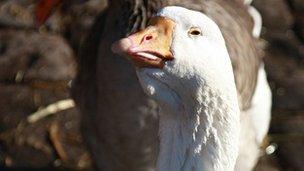Northern Ireland farm agri-crime costs £42m annually
- Published

Some farmers use geese to deter thieves
Rural crime in NI cost £4.2m last year, according to the National Farmers Union insurance company.
Livestock, fuel and expensive power tools were identified as the items most commonly targeted by thieves.
However, the company said there was evidence that farmers were getting more creative in the lengths they will go to deter criminals.
These included the use of geese as 'watch-dogs' and storing quad bikes in a pen behind a bull.
Some farmer kept noisy or aggressive animals, such as llamas, with other livestock in a bid to deter thieves.
The problem was not limited to Northern Ireland. The NFU insurance company said agri-crime across the UK was responsible for claims worth £53m.
The company's Belfast representative, David Cairns, said the thieves were targeting specific items.
Growing trend
"Tools, heating oil... metal, any type of farm machinery, and tractors and livestock seem to be disappearing as well," he said.
The survey found that theft of metal and chemicals had been identified as growing trends over the past twelve months.
Chemicals used for crop-spraying can cost more than £600 for 10 litres and it is believed these are being targeted by organised gangs who ship them abroad to meet demand across Europe.
The PSNI said it did not keep separate statistics for agri-crime but has set up a Rural Crime Task Force in a bid to deal with the problem.
However, according to Freedom of Information data, from 1 January 2009 to 31 January 2012, there was a total of 33 incidents in the Foyle policing area and a total of 39 in the Limavady policing area where the offence type was one of burglary, robbery or theft and the property stolen was livestock or farm equipment or incident location was indicated as a farm.
In the Limavady and Magherafelt policing area, from 1 July 2010 to 31 August 2011, there were 11 recorded burglary, robbery or theft offences where the property stolen was farm equipment or the modus operandi location indicated the offence to have taken place at a farm.